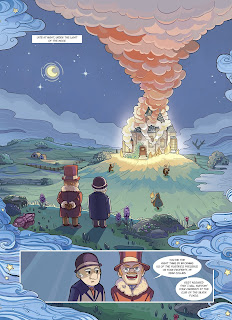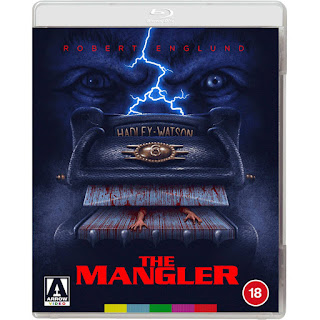'The Warriors Three must traverse space and time to save their realm from magical villainy, in this swashbuckling fantasy adventure from Marvel’s Legends of Asgard
'During a fierce battle to free the people of Skornheim, the valiant Warriors Three – Fandral, Volstagg, and Hogun – encounter an ancient mystic who bears ominous tidings for Asgard. Three sorcerous brothers who call themselves the Enchanters have wrought evil across the realms, and are building armies with which to conquer the Realm Eternal. It has been foreseen that only one heroic trio can end their wicked plot… But the Enchanters are scattered through time and space, each fortified by their magical Living Talisman. The Warriors Three must be cast across the cosmos, to explore strange worlds, and risk life and limb against unimaginable odds to stop these sorcerers before they can overthrow Odin’s rule.'
The Marvel Legends of Asgard novel series has felt like it's had a pretty consistent style since it began. It's been telling stories about the early days of warriors who would go on to become great heroes, some of them even becoming gods as they grow older. As such, I was surprised when the latest entry, Three Swords took a slightly different approach, instead telling a story about the brave Warriors Three after they've been heroes for a while; and its a fun break to the formula.
The story begins with the Warriors Three, Fandral, Volstagg, and Hogun, helping a rebel movement in Skornheim to overthrow their new, corrupt leaders. Working from underground locations, the three legendary heroes are helping to transform the brave folks of Skorheim into warriors who can fight back for their very freedoms. When one of these bases comes under attack the Warriors Three stay behind to buy everyone else time, taking on the soldiers in a desperate fight.
Fleeing the area, hoping to meet back up with the rest of the resistance, the three of them are given shelter by an old man. The three of them soon discover, however, that he's no ordinary villager, and find themselves in the company of an old mystic. With Hogun having no love for magic users the three of them are prepared to fight, but the old wizard informs them that he's there for their help; and that all of Asgard and beyond are at stake. The Warriors Three learn that there are three brothers scattered across the nine realms, in different times and places, who have in their control artefacts that would make them a powerful threat to all life. The old wizard begs the Warriors Three to travel to these places, to fight these magic users, and to secure the artefacts in order to save every realm. Never ones to back down from a noble cause, the three of them set out to save the universe.
The Warriors Three are characters that I've encountered a few times, but usually in supporting roles for heroes such as Thor, Valkyrie, or Loki; and as such I hadn't really spent any great deal of time with these three iconic figures. Three Swords really allows the reader to do this, as not only are there no other Asgardian heroes in the book, I'm struggling to remember if they're even mentioned; as this is very much a story about these three saving the day.
The main plot of the book sees the three heroes having to travel across space and time in order to combat these evil sorcerers, and this leads to some interesting settings, and chances for the three of them to show how capable they are in vary ways. The first location is a futuristic world where alien lizard creatures have taken over, which mirrors nicely with the beginning of the book with the new regime in Skorheim, especially as the three of them have to hook up with the local resistance in order to achieve their goals.
As with any time you combine together fantasy and science fiction this is an interesting part of the book. We have three warriors armed with swords and ancient weaponry fighting aliens flying around on hover bikes, shooting lazers. It's a big tonal whiplash; but it really works. There's something about these characters being thrown into a completely alien environment, surrounded by things they don't understand that's really entertaining.
The second place they go to couldn't be more different, however, and might be my favourite part of the book. The trio find themselves in Nottingham somewhere around the 1640's, as we learn that the British Civil War is either taking place or soon to break out. Its here where we get to explore more of Fandral's time on Earth as Robin Hood (something I knew nothing about until this book!). The pace of the adventure slows down a little here, and we have some quiet moments as Fandral spends time thinking about his past life here, the people he lost, and how much it still pains him. He gets to mourn for his wife, and this shows a side of him we don't often get to see; a more vulnerable man beneath the brave exterior. It was also delightful to have part of this huge fantasy epic take place just up the road from me; as well as in the home of Aconyte Books too!
The final location takes the three heroes to a primordial world filled with dinosaurs that have been twisted by dark magic into vicious monsters. If the Warriors Three fighting aliens and strange plant monsters wasn't cool enough we get them flying around on Pterodactyls; which is a hell of an image for sure. This part of the book might be one of the most unusual, and boldest things that we've had in a Marvel Legends of Asgard book that it might feel too over the top and ridiculous, but you'll be having so much fun with it that you'll not even care.
Over the course of this adventure we spend some time with each member of the Warriors Three, getting to see how they think, their motivations, and what drives them as heroes. Each of them also gets multiple chances to shine, proving that the three of them really are a team, and that if you didn't have all of them together the others simply wouldn't be able to survive. The only one I really felt got any significant development was Fandral, thanks in large part to the section of the book taking place in Nottingham and the exploration of his loss, and I think in some ways it's a shame I didn't feel that greater connection with the other two.
Perhaps this is in part down to the fast paced nature of the story, as things move very quickly across the book, with the characters and readers never really being given a chance to rest and collect their thoughts before being plunged into the next challenge. Whilst I really did enjoy the book I do find myself wishing it had been longer, so that we could have gotten a few more slower paced moments where we could have connected with the characters more.
Three Swords is a fast paced, action packed, fantasy epic that mixes in the science fiction, historical locations, and ridiculously cool concepts into one huge story that shouldn't work, but lands perfectly. It's a real testament to the writing talent of C.L. Werner that they were able to pull it off; and I think their experience in writing both fantasy and science fiction in the past really shows here, as they're able to craft the two together flawlessly. Whether you're a long time fan of the Warriors Three, or just discovering them now, Three Swords will make them a trio that you'll be keeping an eye on in the future.



















